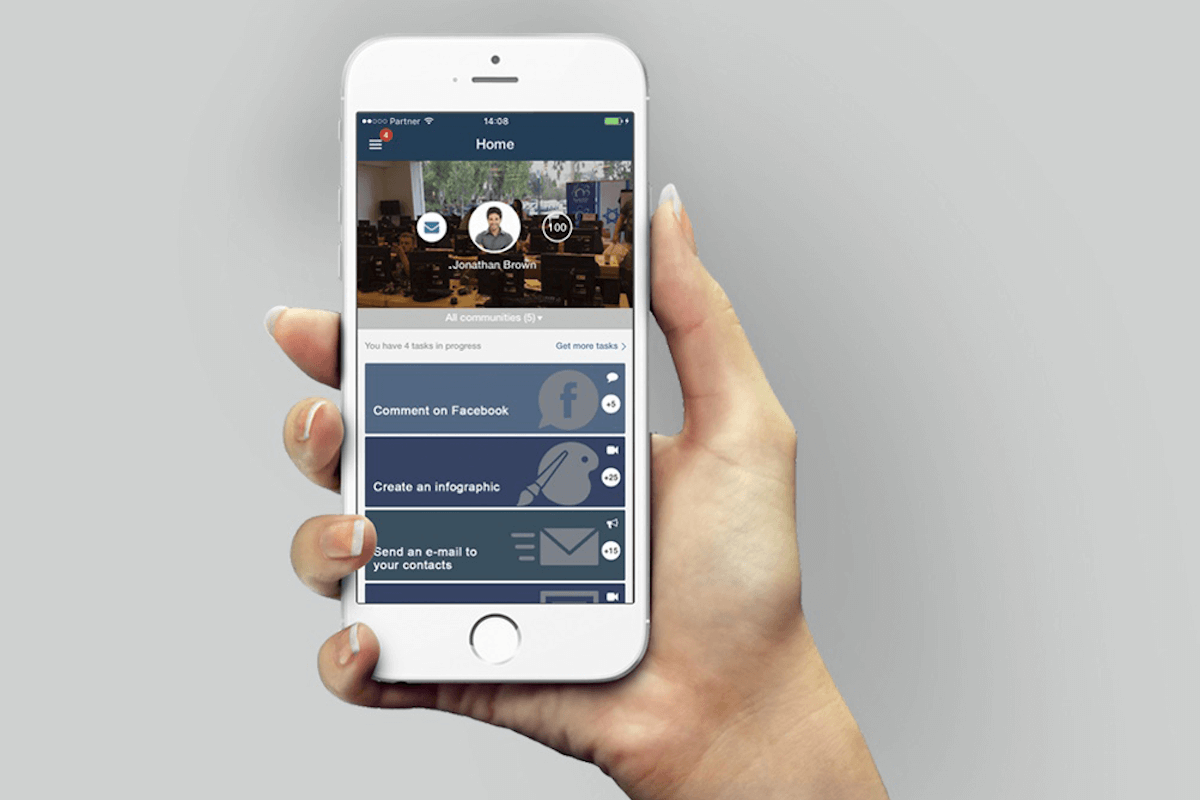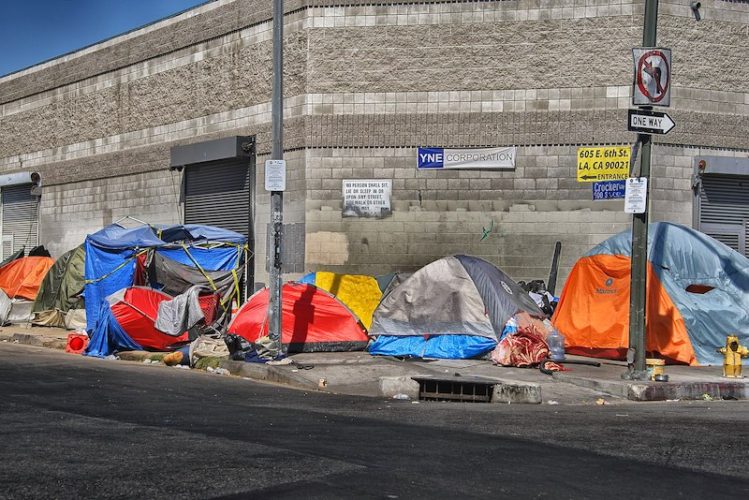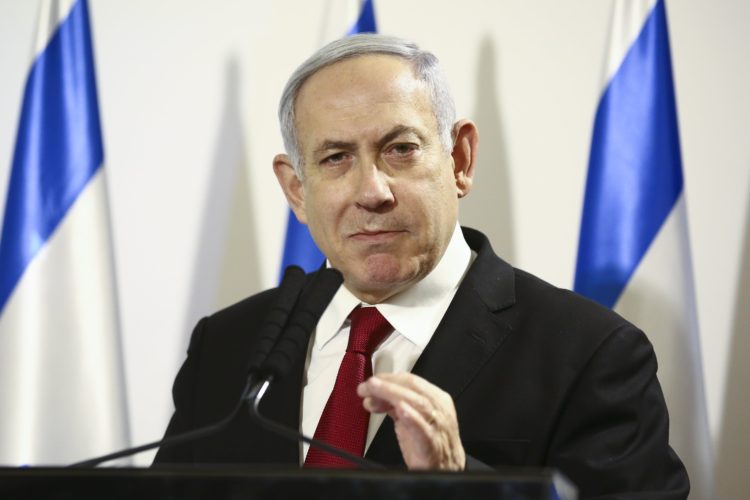When Israel’s military begins to attack,
so does its army of online trolls

A promotional photo for the Act.IL app. (Photo: act-il.com)
Act.IL is a global pro-Israel campaign at least partially funded by the country’s government. The project includes an app that enables users to earn points and prizes for promoting the state of Israel online, by attacking BDS and other pro-Palestinian movements. According to Electronic Intifada reporting from earlier this year, it’s operating with a budget of a more than a million dollars.
Michael Bueckert is a PhD student in sociology and political economy at Carleton University and, since April 2018, he’s maintained a Twitter accountthat tracks the app’s “missions.” Bueckert spoke to Mondoweiss’ Michael Arria about the history of the project, its use during the recent attacks on Gaza, and whether or not it’s actually having an impact on anyone.
Arria: So just to start, I think a lot of people on our site are probably familiar with your work. But for people who maybe are not, can you briefly describe the ACT.IL app and explain who funds it?

Michael Bueckert
Bueckert: Yes. So, for a couple of years now, I’ve been following Israel’s semiofficial propaganda app. It’s called ACT.IL and was set up in a sort of partnership between the Israeli government and a number of American pro-Israel lobby groups funded by Sheldon Adelson. There is a lack of clarity perhaps about the exact nature of that relationship. The app was funded in part by the Israeli government..I think that the government paid for the development of the website that it was hosted on and paid for a lot of advertising including sponsored content, like sponsored articles in Israeli newspapers that look like the are just regular reporting, but were paid for by the Israeli government essentially. At the time the developers of the app were talking about how they were working with the Shin Bet [Israel’s internal security service] and, you know, Israeli defense officials to identify targets online and to have a sort of duty to craft responses. But they’ve kind of backtracked on that.
But basically, it’s an app which anyone in the world can download onto their phone and it identifies targets online or they call them “missions” in which pro-Israel individuals can can very easily participate in online discourse. So, it will identify a tweet for them to read, or it will identify a Facebook comment on a news article that they can like. Essentially, it’s a way of coordinating online behavior in a way that looks organic, but is actually quite choreographed by this sort of centralized body with support from the Israeli government. And yet the intention of it is to very suddenly shape online discourse in a way that’s pro-Israel.
Arria: Do you have any sense of how many people are using the app and carrying out these “missions”?
Bueckert: It is really hard to say at any one point. It doesn’t appear like there are a lot of people. Certainly there are thousands of people who have downloaded the app, possibly tens of thousands. But there’s it’s hard to gauge exactly how many people are active on it on an ongoing basis. A lot of the missions don’t necessarily seem like they have a lot of uptake to them, not a lot of users have participated in many of the missions. So it’s really it’s really difficult to tell.
Arria: Are there particular moments when the app is more active than others?
Bueckert: Again, it’s hard to tell in terms of use, but certainly you can tell by maybe by the amount of missions that the app is producing. There are a whole bunch of different themes. I would say that the missions are more frequent any time that a musician or an artist is traveling to Israel. There is usually a number of missions for the app directing users to comment on their Instagram posts or welcome them to Israel on Twitter, that kind of thing, to sort of combat any boycott pressure that they might be receiving.
Then you have a whole category of more serious or consequential missions where it’s really targeting a specific local issues, usually on a campus where they might target a specific conference or a specific set of students in a way that makes it appear that there is a backlash to a pro-Palestinian organizing in an organic sense when it’s actually choreographed. And in some cases, I mean, the app has boasted of getting people fired or of getting things canceled. So when it puts a target on a local issue, it can really have a big impact.
And then I think the time when you see the most activity is times like right now when there is an escalation of violence, especially with airstrikes on Gaza and corresponding rocket fire. That’s when you have a fairly massive response with a whole range of missions all at once. And whether or not, again, there is an uptick in actual users taking advantage of those missions, I don’t know. But certainly the app is far more active in these times.
Arria: To that point, can you speak to the kinds of missions you’ve seen recently? A ceasefire was recently announced, but Israel has been sending missiles into Gaza for the last couple of days. What’s a typical mission look like when something like this happens?
Bueckert: Right. So right now, there are about 40 missions that are related to this issue. The majority of these missions are targeting news articles, whether on Facebook or on Twitter, where you’ll be asked to leave a comment that questions the terminology used. If the article’s headline says that an Islamic Jihad militant was killed, you’ll be asked to comment, “He’s not a militant, he’s a terrorist.” And so there will be a lot of nitpicking around language, to say, “You missed relevant information” or “This is a biased perspective.” That kind of thing. And I think the overall point of those kinds of missions (especially on Facebook) is to shape the way that ordinary users experience the news and come across those news articles, because what they’re trying to do (and in this case, they’re very successful) is in get these endorsed comments to rise to the top comment right under the article on Facebook. So if you’re a casual user of Facebook and you’re coming across these news articles, the first thing you see right below the headline are these critical comments by random people online and what appears to be an organic natural backlash to that article when it’s actually coordinated. So, I would say that that is the majority of of the missions.
And a lot of them are meant to deflect from the coverage of the fact that it was Israel’s targeted killings of the Islamic Jihad officials which knowingly triggered this latest round of violence. And so a lot of the articles are trying to combat that by saying, you know, there’s rockets all the time, Israel didn’t strike first. There’s also a bunch of missions where they’re sharing Facebook videos, for example, of rocket fire in Israel to say, you know, this is what life is like under terrorism from Gaza, that kind of thing.
Some of the missions are kind of offensive. One of them is sharing a video of a man in Israel and how his dog is being harmed emotionally by the rocket fire, so promoting the welfare of dogs in Israel. Meanwhile, I think at this point in time about 36 Palestinians have been killed. Four of them are children. And so [the missions are about] avoiding any questions of Palestinian casualties and trying to put all of the blame on Gaza. And so those are those are the kinds of missions that are that are flooding the app at this moment.
Arria: I know it’s impossible to quantify what impact something like this is having, but do you personally feel like it’s moving the needle any in terms of pro-Israel sentiment?
Bueckert: It really is impossible to tell. There have been a couple attempts to look at this. [One study] suggested that a lot of the traffic for the landing page that they created actually came from my Twitter account exposing it rather than from the app itself. And so that suggests that there’s very little take up, at least there has been on previous occasions.
The Electronic Intifada did some reporting on this as well that raises some questions about the effectiveness of this, especially considering the amount of money and resources that are being put into it. I think it’s really impossible to tell whether or not liking comments on Facebook and Twitter makes any difference, but I suspect that it’s minimal at best.
Although again, I would say that when it comes to missions that are more targeted, that go after specific individuals and go after people’s employment or try to get conferences canceled, those are the ones that do appear to be quite effective. There was a case earlier this year where the app had many missions going after [California’s Ethnic Studies Model Curriculum Advisory Committee] for proposing an ethnic studies program which positively talked about Palestinians and BDS as a social movement. And there were many missions that were targeting specific school board trustees and sending emails to the individuals on the curriculum committee. So, when it comes to those specific instances, I think the app can be quite powerful. But when it comes to just trying to shape the general reaction to an event like the current airstrikes and rockets, I have no idea.
Arria: Has tracking the app given you any sense of how seriously Israel takes the BDS movement? On one hand you consistently hear pro-Israel groups mock the movement for having a negligible impact, but then there’s also vast resources being used to combat it like we see here.
It’s a debate in Israel itself and between different ministries even about whether [BDS] is actually a threat or something that is worth putting resources into. The Ministry of Strategic Affairs, obviously that’s what it’s whole deal is. But in foreign affairs, I think their understanding is that they’d rather just ignore it and let it go away, so it’s hard to tell what they actually think.
The amount of resources that they put into these kinds of campaigns, what does it suggest? Well, I don’t think it necessarily suggests that [they believe BDS is a real threat], but rather that they are not willing to allow any pro Palestinian sentiment to become accepted within today’s discourse. My impression is that is all less about the actual threat of BDS and more about the absolute intolerance towards any thing positive about the Palestinians.





